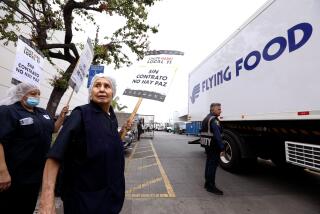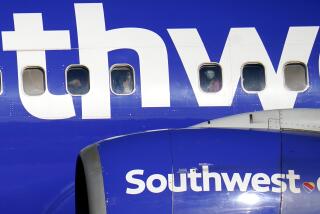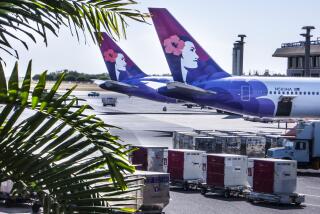Ex-Stews Agree: It Was Fun Up There
They relived war stories about working under potentially dangerous conditions for as little as $1.25 an hour. They recalled the constant uniform and grooming checks, and how their work restricted their personal life with the demanding, long hours.
But mainly they remembered that for a time, theirs was the most coveted job for a woman in the United States. And they were proud to have worn the wings.
About 30 former airline stewardesses met at Promontory Point Clubhouse in Newport Beach last weekend in what they called Interline â90, a celebration of the 60th anniversary of stewardess service.
Kathleen OâBrien, who flew with Braniff in the â60s, said being a stewardess was the female equivalent of men playing sports or going to war.
Being a stewardess, she said, âwas a bonding thing for women, a way to get tested, a way to find out how you would react in an emergency. It wasnât just coffee tea or me. It was being responsible for getting people off that plane if you had to.â
Thousands of women competed for a job that had a relatively good salary, unlimited travel and the opportunity to âdrench yourself in celebrities and sports figures,â said Kathy LaBelle, who flew for United Airlines in the early â60s.
âTo go home and say, âGuess what, Dad, United selected me,â well you just canât imagine,â she said. âYou were proud to be selected. You knew you were special.â
Most of the flying veterans who attended the event said they werenât grounded by old age but by marriage.
âIt was part of your contract to quit when you married,â LaBelle said. âThe airlineâs reasoning was purely aesthetics, the myth of the pretty single . . . woman who serves the male.â
âThis used to be a specialty thing with sincere camaraderie,â said Gail Preston, who flew for United Airlines from 1960 to 1964, retired, then founded the Orange County chapter of Clipped Wings, an association of United stewardess alumnae. âYou took it knowing that when you got married, you could never fly again. It was tough, because it was a great job back then.â
The story of trading wings for rings was repeated many times by the women who ranged in age from late 40s to early 70s.
Held by the 40-member county chapter of Clipped Wings, the festivities included an airline fashion show, with ensembles ranging from 1930s conservative dark suits to a 1960s navy-blue minidress with bright orange coat, helmet hat and tall black boots.
The evening was the countyâs first inter-airline social event, said Mary K. Dana, president of the Clipped Wings chapter, another former stew who quit flying to marry. She said although lawsuits alleging discrimination on the basis of age, sex and marital status began in the â60s, âitâs only been in the past few years that the restrictions were lifted.â
âIn the â30s through the â60s,â Dana said, âwe just wanted to be a stew, get married and live Doris Day (lives), happily forever. Now itâs more of a career for both males and females, married or not.â
âWe lived in a bubble,â said LaBelle, who is now a CPA and divorced. âOn one end, you had some women demonstrating for equal rights on college campuses. On the other end, being a stewardess was the most coveted job in the United States.â
Memories were dished out throughout dinner as the veterans from Pan Am, Braniff, United and TWA ate pastas and traded tales of glamorous days gone by.
Sally Vigal, who started her three-year career in 1949, said she flew then on a 27-seat DC-3 that skimmed snowy mountaintops at low altitudes, landing 14 times between Denver and Chicago. Next she graduated to DC-6 sleepers with a lounge at the tail.
âThey were big beautiful things that seated 104 people,â she said. âIt was just like a train. Weâd point out all the sights, then pull down the berths and theyâd go to sleep.â
It all began in 1930, when eight registered nurses became the first female flight attendants on a U.S. airline, Boeing Air Transport, a United Airlines forerunner, said Dana, who displayed a picture poster with a caption that said the dream of every young man was to marry an airline stewardess.
âThese were daring young women in those days,â she said. âExcept for nurses, most women didnât even leave home.â
But their boldness had to be wrapped in a young and dainty package. Besides being required to be unmarried nurses, the original stews had to weigh less than 115 pounds, stand shorter than 5 feet, 4 inches and be younger than 25.
The monthly salary was $125 for 100 hours of flying time in 10-seat tri-motor planes that reached a maximum of 125 m.p.h., Dana said, as she set the stage for a fellow Clipped Wings member who was to model the first uniform, a green-caped affair with beret jauntily tilted above one eye.
The idea of women attendants was the brainchild of Ellen Church, a nurse who proposed the idea to Steve Stimpson, a San Francisco division traffic agent for Boeing Air Transport.
In 1930, Stimpson wrote a letter to a company official rhapsodizing a concept of women attendants and the advantage of having nurses to treat air sickness.
âImagine the psychology of having young women as regular members of the crew,â the letter said. âImagine the national publicity we could get from it, and the tremendous effect it would have on the traveling public. Also, imagine the value they would be to us in the neater and nicer method of serving food and looking out for the passengersâ welfare.â
Stimpsonâs superiors at first thought it was a âridiculous ideaâ but finally consented to a trial program with Church and seven other nurses, Dana said.
âThe passengers loved it,â she said. âPilots were converted. And the other airlines quickly hopped aboard and employed young nurses, a requirement that stayed in effect through World War II.â
Bunny Fifer, a registered nurse then working in Sacramento, was hired by United in 1939, with an annual salary of $1,500. A scrapbook she made holds photos of passengers to whom she served three-course meals, including Bud Abbott, Lou Costello, Rita Hayworth and Walt Disney.
âI loved every minute of it,â she said. âWe were treated like celebrities. Every time we walked down the street people would say âOh, thereâs a stewardess.â â
Grooming rules were very strict, Fifer said: Hair couldnât touch the collar, earrings werenât allowed and uniforms with blue-and-white shoes had to look âjust so.â
âWe were on inspection every time we went through the terminal,â she said. âAnd passengers really got dressed up to fly then, with hats and the whole bit.â
The Clipped Wings members are glad married women can now fly, but they bemoan other changes. âItâs not as personal or prestigious any more,â said Preston, who is now a technical administrator for a computer company.
âIt used to be 30 or 40 people in the back of the plane to Denver for four hours. Now itâs 200 people and takes an hour. It has lost its cachet.â
âIn the old days,â Vigal said, âwe played bridge, took care of babies and knew everyoneâs names by the time they got off the plane. Now you have huge airplanes, huge crews and stewardesses work much harder. Itâs just not the same.â
Jennifer Pavitt, who flew for TWA, agreed. âStewardesses today are missing out,â she said with a clipped English accent. âWe have bigger and better airplanes, but you lose something. Itâs that feeling of belonging.
âBut if I were 20 now, Iâd still want to fly.â
More to Read
Sign up for The Wild
Weâll help you find the best places to hike, bike and run, as well as the perfect silent spots for meditation and yoga.
You may occasionally receive promotional content from the Los Angeles Times.






